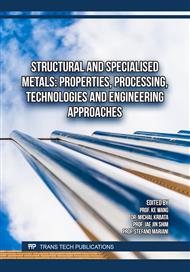p.3
p.13
p.25
p.37
p.49
p.63
p.69
p.75
p.91
Study of Weldability of FSPR Joints in Steel/Al Alloy Hybrid Body
Abstract:
The promotion of green and low-carbon initiatives has spurred the application of lightweight materials in steel/Al car bodies. The development and utilization of large Al alloy die-casting (DCAA) materials and thermo-formed steel plates (TFSS) impose higher demands on joining technologies of the steel/Al dissimilar material. Taking the innovative body with DCAA and TFSP as a case, this paper systematically investigates the principles, characteristics and forming progress of force-self-piercing riveting(FSPR) joining technology for two-layer and three-layer plates with DCAA and TFSP. The types of test samples, the combination of plates and the test methods of mechanical properties are designed. Using the TL4225/C611/CR5 plate combination, the riveting and forming processing, the microstructures and morphologies were studied. Based on it, the methods to achieve high-quality joints were obtained. For the joining of two-layer plates containing DACC and TFSP, better joint forming and higher joint strength can be obtained for the ideal arc gap filling. For the joining of three-layer plates, TFSP will affect the filling effect for the elastic-plastic deformation of the middle layer during the forming. Although the joint can meet the product design, but the strength index is significantly lower than that of the two-layer plates. Based on the relevant data in the course of this experiment, general rules of product design for FSPR joining, such as joining space, flange edge size, plate strength and plate thickness, were analyzed and summarized combining plate characteristics, plate combination, die structure, joining method, joint strength and weld accessibility. The study will provide the technical support for the application of DCAA parts and TFSP in car bodies.
Info:
Periodical:
Pages:
49-59
Citation:
Online since:
June 2025
Authors:
Keywords:
Price:
Сopyright:
© 2025 Trans Tech Publications Ltd. All Rights Reserved
Share:
Citation:



